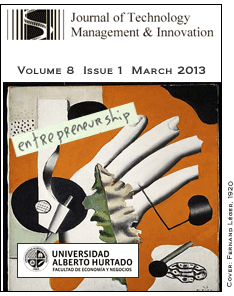Desafíos Interdisciplinarios en la Formación Universitaria: una Contribución desde la Facultad de Diseño de la Universidad del Desarrollo
DOI:
https://doi.org/10.4067/S0718-27242013000100009Keywords:
Interdisciplina – Proceso Creativo – Resolución de Problemas – Diseño – InnovaciónAbstract
The ability to work in an interdisciplinary manner in order to respond to the creative challenges imposed by a complex and changing marketplace is an absolute necessity for professionals in modern day companies (CINDA, 2000), (OECD, 2005) where a product cannot be created by an individual alone. (Mamykina, Candy & Edmonds, 2002). It generates an overlap of responsibilities between different professional disciplines and creates an interdependence between them in order to design and the produce innovative goods.The first part of this paper recognizes the necessity of incorporating creative and interdisciplinary abilities at all levels within a business and how this clearly extends to university programs. (Vanhamaa, 2006), (Boni, Weingart & Evenson, 2012), (Itkonen, Ekman, & Kojo, 2009).The second part presents how Universidad del Desarrollo responds to these challenges through the creation of the Institute for Interdisciplinary Innovation (Instituto de Innovación Interdisciplinaria ICUBO), which is born from the Departments of Design, Engineering and Economics and Business.Downloads
References
ALBORNOZ, C. A. (2011). Goals, Content, and Methods of Entrepreneurship Education: A Multiple Case Study. Florida International University.
BLAIR, B. (2011). Elastic minds? Is the interdisciplinary/multidisciplinary curriculum equipping our students for the future: A case study. Art, Design & Communication In Higher Education, 10(1), 33-50. doi:10.1386/adch.10.1.33_1
BONI, Arthur A., Laurie R. Weingart, and Shelley Evenson. (2009) Innovation in an Academic Setting: Designing and Leading a Business Through Market-Focused, Interdisciplinary Teams. Academy Of Management Learning & Education 8, no. 3 407-417. Business Source Complete, EBSCOhost (accessed November 10, 2012).
BROWN, Tim. (2008). Design Thinking. Harvard Business Review.
CHHABRA, Esha. (2011). Stanford's Institute of Design: School for world changers. Christian Science Monitor, September 30. N.PAG. Academic Search Complete, EBSCOhost (accessed November 10, 2012).
CINDA. (2000) Centro Interuniversitario De Desarrollo-Cinda. Fondo De Desarrollo Institucional. Ministerio De Educación-Chile. Las Nuevas Demandas Del Desempeño Profesional Y Sus Implicancias Para La Docencia Universitaria.
DE GEUS,A. P. (1988). Planning as learning. Harvard Business Review, 88(2), 70-74.
DUDERSTADT, J. (2008). Engineering for a Changing World. A Roadmap to the Future of Engineering Practice, Research, and Education. The Millenium Project. The University of Michigan. United States.
DYM, C. L., Agogino, A. M., Eris, O., Frey, D. D., & Leifer, L. J. (2005). Engineering Design Thinking, Teaching, and Learning. Journal Of Engineering Education, 94(1), 103-120.
HOLT, K. (1977). Creativity--a new challenge to the industrial engineer. International Journal of Production Research, 15(5), 411.
ITKONEN, M., Ekman, K., & Kojo, I. (2009). Murjottelu - interdisciplinary training campaign for industrial design and engineering students. European Journal Of Engineering Education, 34(3), 263-271. doi:10.1080/03043790903038858
KAUFMAN, J. C., & Beghetto, R. (2009). Beyond Big and Little:The Four C Model of Creativity. Review of General Psycology.
MAMYKINA, L., Candy, L., & Edmonds, E. (2002). Collaborative Creativity. Communications Of The ACM, 45(10), 96-99.
MANZINI, E., Vezzoli, C. (2008). Design for Environmental Sustainability. INDACO Department. Politécnico de Milán. Italia
MCDONALD, J. (2011). The Creative Spirit of Design. Techtrends: Linking Research & Practice To Improve Learning, 55(5), 53-58. doi:10.1007/s11528-011-0528-2
OBRADORS, M. (2007). Creatividad y Generación de Ideas. Universidad Autónoma de Barceloma. Servei Publicaciones. Universidad de Valencia. España.
OECD. (2005) Selection and definition of Key competencies. [ Links ] PARENTE, D. E. (2006) Advertising campaign strategy: A guide to market communication plans (4th ed.). Mason, OH: Thomson South Western.
PEREZ, C. (2002). Technological Revolutions and Financial Capital: The Dynamics of Bubbles and Golden Ages (p. 208). Edward Elgar Pub.
ROBINSON, K. (2006) The Element: How Finding Your Passion Changes Everything
SPOHRER, J., & Maglio, P. P. (2008).The Emergence of Service Science: Toward Systematic Service Innovations to Accelerate Co-Creation of Value. Production and Operations Management, 17(3), 238–246. doi:10.3401/poms.1080.0027
Downloads
Published
How to Cite
Issue
Section
License
Copyright (c) 2013 Journal of Technology Management & Innovation

This work is licensed under a Creative Commons Attribution-ShareAlike 4.0 International License.







